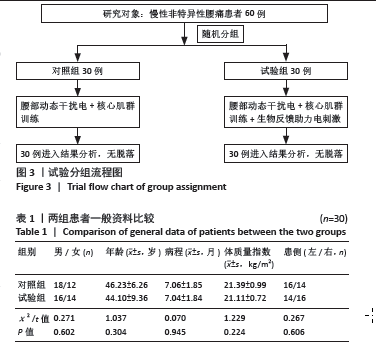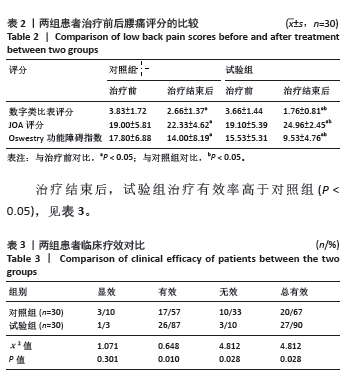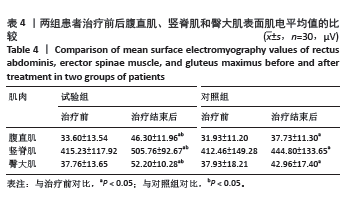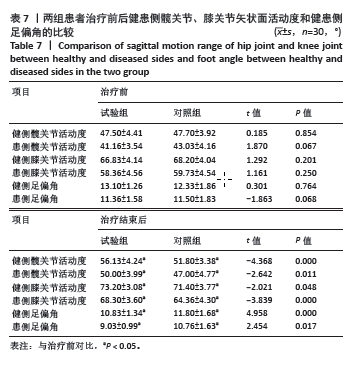[1] ANAÏS G,ANNE T,FLORENT M, et al. Sensitivity and specificity of the flexion and extension relaxation ratios to identify altered paraspinal muscles’ flexion relaxation phenomenon in nonspecific chronic low back pain patients. J Electromyogr Kinesiol. 2023;68: 102740.
[2] 李芳蕾,阿依达娜·哈力木,米立新,等.慢性非特异性下腰痛的康复治疗研究新进展[J].中国老年保健医学,2022,20(4):103-107.
[3] MARIA C,LUIS L,DAVID V, et al. Core Synergies Measured with Ultrasound in Subjects with Chronic Non-Specific Low Back Pain and Healthy Subjects: A Systematic Review. Sensors (Basel). 2022; 22(22):8684.
[4] 刘晓龙,何梦晓,尹贻锟,等.核心稳定康复训练系统对慢性非特异性腰痛干预效果研究[J].中国全科医学,2023,26(9): 1064-1074.
[5] 中国康复医学会脊柱脊髓专业委员会专家组.中国急/慢性非特异性腰背痛诊疗专家共识[J].中国脊柱脊髓杂志,2016,26(12): 1134-1138.
[6] PETER K, DANIELA V, MICHAELA S, et al. Adherence and Effect of Home-Based Rehabilitation with Telemonitoring Support in Patients with Chronic Non-Specific Low Back Pain: A Pilot Study. Int J Environ Res Public Health. 2023;20(2):1504.
[7] 黄武杰,刘红,李雅萍,等.疼痛缓解对慢性非特异性腰痛患者步态特征的影响[J].中国康复理论与实践,2021,27(2):197-202.
[8] 吴昌师,夏寿涛,曾珊.立体干扰电结合核心肌力训练治疗非特异性下腰痛的疗效观察[J].当代医学,2021,27(12):106-108.
[9] LARA-PALOMO CI, AGUILAR-FERRÁNDIZ EM, MATARÁN-PEÑARROCHA AG, et al. Short-term effects of interferential current electro-massage in adults with chronic non-specific low back pain: a randomized controlled trial. Clin Rehabil. 2013;27(5):439-449.
[10] KUMAR T, KUMAR S, NEZAMUDDIN M, et al. Efficacy of core muscle strengthening exercise in chronic low back pain patients. J Back Musculoskelet Rehabil. 2015;28(4):699-707.
[11] 曾菊,邹智,钟地养,等.运动疗法对慢性非特异性腰痛患者肌电特征影响的研究进展[J].中国康复医学杂志,2022,37(9):1283-1288.
[12] 李硕,刘丽爽,周金娜,等.核心稳定性训练联合体外冲击波治疗腰椎间盘突出症疗效观察[J].康复学报,2019,29(6):16-20.
[13] 董煜琳,王惠芳,郑依粒,等.不同振动条件对慢性下背痛患者腰腹部肌群表面肌电信号的影响[J].中国康复医学杂志,2018,33(3): 297-303.
[14] 郭霞,陈楚杰,庞贤妹,等.非特异性腰痛的运动疗法研究[J].科技视界,2021(11):91-93.
[15] 王鑫.核心肌力训练治疗慢性非特异性腰痛的临床研究[J].现代医药卫生,2019,35(23):3682-3683.
[16] 冉丽,刘佳妮,马佐瑶,等.深层肌肉刺激仪联合核心稳定训练治疗非特异性下腰痛的表面肌电图研究[J].按摩与康复医学,2021, 12(10):25-27.
[17] 谢兵,李辉,罗建.中医非药物疗法治疗慢性非特异性腰痛研究进展[J].实用中医药杂志,2022,38(12):2253-2255.
[18] 孔颖,朱海峰,万全庆.万全庆治疗慢性非特异性腰痛经验[J].新中医,2023,55(10):189-192.
[19] 刘夕源,胡晓丽.核心稳定训练治疗慢性非特异性腰痛研究进展[J].按摩与康复医学,2023,14(5):46-50.
[20] 张欣.腹式呼吸干预下的三种桥式运动对人体核心区表层肌肉IEMG影响的研究[D].石家庄:河北师范大学,2020.
[21] 翟永夷,崔燕红,徐浩坤.核心稳定运动对慢性非特异性腰痛患者β-内啡肽和皮质醇水平的影响[J].颈腰痛杂志,2021,42(1):100-102.
[22] FRIZZIERO A, PELLIZZON G, VITTADINI F, et al. Effica‐cy of core stability in non-specific chronic low back pain. J Funct Morphol Kinesiol. 2021; 6(2):37.
[23] 范飞.肌电生物反馈放松训练对下背痛伴疼痛灾难化患者的康复疗效观察[D].承德:承德医学院,2017.
[24] 史景.电针委中穴对下腰痛患者表面肌电特征的影响[D].郑州:河南中医药大学,2018.
[25] 刘斯文,李华南,海兴华,等.慢性腰痛患者表面肌电图临床特征及数据分析[J].中国康复医学杂志,2017,32(12):1361-1365.
[26] 印杰松,陆桂伟.表面肌电生物反馈指导对慢性非特异性腰背痛康复训练的疗效影响[J].颈腰痛杂志,2019,40(5):687-689.
[27] 王泽熙.表面肌电生物反馈指导下的康复训练治疗慢性非特异性下背痛的疗效观察[D].承德:承德医学院,2018.
[28] GONÇALVES MLC, FERNANDES S, DE SOUSA JB. Do moderate aerobic exercise and strength training influence electromyographic biofeedback of the pelvic floor muscles in female non-athletes? J Phys Ther Sci. 2018;30(2):313-319.
[29] MAYER TG, NEBLETT R, BREDE E, et al. The quantified lumbar flexion-relaxation phenomenon is a useful measurement of improvement in a functional restoration program. Spine (Phila Pa 1976). 2009;34(22): 2458-2465.
[30] TSAO H, HODGES PW. Persistence of improvements in postural strategies following motor control training in people with recurrent low back pain. J Electromyogr Kinesiol. 2008;18(4):559-567.
[31] SOLOMONOW M, HATIPKARASULU S, ZHOU BH, et al. Biomechanics and electromyography of a common idiopathic low back disorder. Spine (Phila Pa 1976). 2003;28(12):1235-1248.
[32] LUND JP, DONGA R, WIDMER CG, et al. The pain-adaptation model: a discussion of the relationship between chronic musculoskeletal pain and motor activity. Can J Physiol Pharmacol. 1991;69(5): 683-694.
[33] BOGDUK N, MACINTOSH JE, PEARCY MJ. A universal model of the lumbar back muscles in the upright position. Spine (Phila Pa 1976). 1992;17(8): 897-913.
[34] HODGES PW, RICHARDSON CA. Inefficient muscular stabilization of the lumbar spine associated with low back pain: a motor control evaluation of transversus abdominis. Spine (Phila Pa 1976). 1996;21(22):2640-2650.
[35] HOLCOMB WR, RUBLEY MD, LEE HJ, et al. Effect of hamstring-emphasized resistance training on hamstring: quadriceps strength ratios. J Strength Cond Res. 2007;21(1):41-47.
[36] 罗卫,钟陶,高燕,等.慢性非特异性腰痛患者的三维步态功能分析[J].中国疗养医学,2023,32(3):273-276.
[37] CASTRO-MÉNDEZ A, REQUELO-RODRÍGUEZ I, PABÓN-CARRASCO M, et al. A Case-ControlStudy of the Effectsof Chronic Low Back Pain in Spatiotemporal Gait Parameters. Sensors(Basel). 2021;21(15):5247.
[38] 陈晓蓝,王琳,梁孝天,等.青年慢性非特异性腰痛患者步态:时空和动力学参数特征[J].中国组织工程研究,2019,23(4):556-561.
[39] VEEGER TTJ, VANTRIGT B, HU H, et al. Fear of movement is not associated with trunk movement variability during gait in patients withlow backpain. Spine J. 2020;20(12):1986-1994. |




